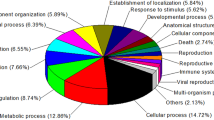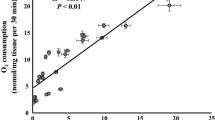Abstract
Enterocytes of young pigs are known to use glutamine, glutamate, and glucose as major metabolic fuels. However, little is known about the roles of aspartate, alanine, and fatty acids as energy sources for these cells. Therefore, this study simultaneously determined the oxidation of the amino acids and glucose as well as short- and long-chain fatty acids in enterocytes of developing pigs. Jejunal enterocytes were isolated from 0-, 7-, 14- and 21-day-old piglets, and incubated at 37 °C for 30 min in Krebs–Henseleit bicarbonate buffer (pH 7.4) containing 5 mM d-glucose and one of the following: d-[U-14C]glucose, 0.5–5 mM l-[U-14C]glutamate, 0.5–5 mM l-[U-14C]glutamine, 0.5–5 mM l-[U-14C]aspartate, 0.5–5 mM l-[U-14C]alanine, 0.5–2 mM l-[U-14C]palmitate, 0.5–5 mM [U-14C]propionate, and 0.5–5 mM [1-14C]butyrate. At the end of the incubation, 14CO2 produced from each 14C-labeled substrate was collected. Rates of oxidation of each substrate by enterocytes from all age groups of piglets increased (P < 0.05) gradually with increasing its extracellular concentrations. The rates of oxidation of glutamate, glutamine, aspartate, and glucose by enterocytes from 0- to 21-day-old pigs and of alanine from newborn pigs were much greater (P < 0.05) than those for the same concentrations of palmitate, propionate, and butyrate. Compared with 0-day-old pigs, the rates of oxidation of glutamate, aspartate, glutamine, alanine, and glucose by enterocytes from 21-day-old pigs decreased (P < 0.05) markedly, without changes in palmitate oxidation. Oxidation of alanine, propionate, butyrate and palmitate by enterocytes of pigs was limited during their postnatal growth. At each postnatal age, the oxidation of glutamate, glutamine, aspartate, and glucose produced much more ATP than alanine, propionate, butyrate and palmitate. The degradation of glutamate was initiated primarily by glutamate-pyruvate and glutamate-oxaloacetate transaminases. Our results indicated that amino acids (glutamate plus glutamine plus aspartate) are the major metabolic fuels in enterocytes of 0- to 21-day-old pigs.
Similar content being viewed by others
Abbreviations
- CPT-1:
-
Carnitine palmitoyltransferase-1
- GDH:
-
Glutamate dehydrogenase
- GOT:
-
Glutamate–oxaloacetate transaminase
- GPT:
-
Glutamate-pyruvate transaminase
- KHB:
-
Krebs–Henseleit bicarbonate
- PFK:
-
Phosphofructokinase
References
Assaad H, Zhou L, Carroll RJ, Wu G (2014) Rapid publication-ready MS-Word tables for one-way ANOVA. Springerplus 3:474
Beaumont M, Blachier F (2020) Amino acids in intestinal physiology and health. Adv Exp Med Biol 1265:1–20
Blachier F, Guihot-Joubrel G, Vaugelade P, Le Boucher J, Pierre-Henri Duée FB, Cynober L (1999) Portal hyperglutamatemia after dietary supplementation with monosodium glutamate in pigs. Digestion 60:349–357
Blachier F, Boutry C, Bos C, Tomé D (2009) Metabolism and functions of l-glutamate in the epithelial cells of the small and large intestines. Am J Clin Nutr 90(suppl):814S-S821
Chalvon-Demersay T, Luise D, Le Floc’h N, Tesseraud S, Lambert W, Bosi P, Trevisi P, Beaumont M, Corrent E (2021) Functional amino acids in pigs and chickens: implication for gut health. Front Vet Sci 8:663727
Chen LX, Yin YL, Jobgen WS, Jobgen SC, Knabe DA, Hu WX, Wu G (2007) In vitro oxidation of essential amino acids by intestinal mucosal cells of growing pigs. Livest Sci 109:19–23
Chen LX, Li P, Wang JJ, Li XL, Gao HJ, Yin YL, Hou YQ, Wu G (2009) Catabolism of nutritionally essential amino acids in developing porcine enterocytes. Amino Acids 37:143–152
Curthoys NP, Watford M (1995) Regulation of glutaminase activity and glutamine metabolism. Annu Rev Nutr 15:133–159
Dillon EL, Wu G (2021) Cortisol enhances ctrulline synthesis from proline in enterocytes of suckling piglets. Amino Acids 53:1957–1966
Eugenio FA, van Milgen J, Duperray J, Sergheraert R, Le Floc'h N (2022) Feeding intact proteins, peptides, or free amino acids to monogastric farm animals. Amino Acids 54:157–168
Flynn NE, Knabe DA, Mallick BK, Wu G (2000) Postnatal changes of plasma amino acids in suckling pigs. J Anim Sci 78:2369–2375
Furukawa K, He WL, Bailey CA, Bazer FW, Toyomizu M, Wu G (2021) Polyamine synthesis from arginine and proline in tissues of developing chickens. Amino Acids 53:1739–1748
He Y, Deen J, Shurson GC, Wang K, Chen C, Keisler DH, Li YZ (2016) Identifying factors contributing to slow growth in pigs. J Anim Sci 94:2103–2116
He WL, Furukawa K, Leyva-Jimenez H, Bailey CA, Wu G (2018) Oxidation of energy substrates by enterocytes of 0- to 42-day-old chickens. Poult Sci 97(E-Suppl 1):3
He WL, Hou YQ, Wu G (2019) Glutamate and glutamine are the major metabolic fuels in enterocytes of suckling piglets. J Anim Sci 97(Suppl 3):68
He WL, Furukawa K, Bailey CA, Wu G (2022) Oxidation of amino acids, glucose, and fatty acids as metabolic fuels in enterocytes of post-hatching developing chickens. J Anim Sci. https://doi.org/10.1093/jas/skac053
Hou YQ, Wu G (2018) l-Glutamate nutrition and metabolism in swine. Amino Acids 50:1497–1510
Hurley WL (2015) Composition of sow colostrum and milk. In: Farmer C (ed) The gestating and lactating sow. Wageningen Academic Publishers, Wageningen, pp 193–229
Jia SC, Li XY, Zheng SX, Wu G (2017) Amino acids are major energy substrates for tissues of hybrid striped bass and zebrafish. Amino Acids 49:2053–2063
Lachica M, Rodríguez-López JM, González-Valero L, Fernández-Fígares I (2018) Iberian pig adaptation to acorn consumption: II. Net portal appearance of amino acids. PeerJ 6:e6137
Li XY, Zheng SX, Jia SC, Song F, Zhou CP, Wu G (2020a) Oxidation of energy substrates in tissues of largemouth bass (Micropterus salmoides). Amino Acids 52:1017–1032
Li XY, Zheng SX, Wu G (2020b) Nutrition and metabolism of glutamate and glutamine in fish. Amino Acids 52:671–691
Li XY, Han T, Zheng SX, Wu G (2021) Nutrition and functions of amino acids in aquatic crustaceans. Adv Exp Med Biol 1285:169–198
McGarry JD, Mills SE, Long CS, Foster DW (1983) Observations on the affinity for carnitine, and malonyl-CoA sensitivity, of carnitine palmitoyltransferase I in animal and human tissues: demonstration of the presence of malonyl-CoA in non-hepatic tissues of the rat. Biochem J 214:21–28
Reeds PJ, Burrin DG, Jahoor F, Wykes L, Henry J, Frazer EM (1996) Enteral glutamate is almost completely metabolized in first pass by the gastrointestinal tract of infant pigs. Am J Physiol 270:E413–E418
Reeds PJ, Burrin DG, Stoll B, Jahoor F, Wykes L, Henry J, Frazer ME (1997) Enteral glutamate is the preferential source for mucosal glutathione synthesis in fed piglets. Am J Physiol 273:E408–E415
Reeds PJ, Burrin DG, Stoll B, Jahoor F (2000) Intestinal glutamate metabolism. J Nutr 130:978S-982S
Rezaei R, San Gabriel A, Wu G (2022) Dietary supplementation with monosodium glutamate enhances milk production by lactating sows and the growth of suckling piglets. Amino Acids. https://doi.org/10.1007/s00726-022-03147-3
Self JT, Spencer TE, Johnson GA, Hu J, Bazer FW, Wu G (2004) Glutamine synthesis in the developing porcine placenta. Biol Reprod 70:1444–1451
Steel RGD, Torrie JH (1980) Principles and procedures of statistics. McGraw-Hill, New York
Stoll B, Burrin DG (2006) Measuring splanchnic amino acid metabolism in vivo using stable isotopic tracers. J Anim Sci 84(Suppl):E60–72
Wang J, Chen L, Li P, Li X, Zhou H, Wang F, Li D, Yin Y, Wu G (2008) Gene expression is altered in piglet small intestine by weaning and dietary glutamine supplementation. J Nutr 138:1025–1032
Wang WW, Wu ZL, Dai ZL, Yang Y, Wang JJ, Wu G (2013) Glycine metabolism in animals and humans: implications for nutrition and health. Amino Acids 45:463–477
Wang WW, Wu ZL, Lin G, Hu SD, Wang B, Dai ZL, Wu G (2014) Glycine stimulates protein synthesis and inhibits oxidative stress in pig small-intestinal epithelial cells. J Nutr 144:1540–1548
Wu G (1995) Urea synthesis in enterocytes of developing pigs. Biochem J 312:717–723
Wu G (1997) Synthesis of citrulline and arginine from proline in enterocytes of postnatal pigs. Am J Physiol 272:G1382–G1390
Wu G (2018) Principles of animal nutrition. CRC Press, Boca Raton
Wu G (2022) Amino acids: biochemistry and nutrition. CRC Press, Boca Raton
Wu G, Thompson JR (1987) Ketone bodies inhibit leucine degradation in chick skeletal muscle. Int J Biochem 19:937–943
Wu G, Thompson JR (1990) The effect of glutamine on protein turnover in chick skeletal muscle in vitro. Biochem J 265:593–598
Wu G, Knabe DA, Flynn NE (1994) Synthesis of citrulline from glutamine in pig enterocytes. Biochem J 299:115–121
Wu G, Knabe DA, Yan W, Flynn NE (1995a) Glutamine and glucose metabolism in enterocytes of the neonatal pig. Am J Physiol 268:R334–R342
Wu G, Flynn NE, Yan W, Barstow DG (1995b) Glutamine metabolism in chick enterocytes: absence of pyrroline-5-carboxylate synthase and citrulline synthesis. Biochem J 306:717–721
Wu G, Haynes TE, Li H, Meininger CJ (2000) Glutamine metabolism in endothelial cells: ornithine synthesis from glutamine via pyrroline-5-carboxylate synthase. Comp Biochem Physiol A 126:115–123
Wu G, Knabe DA, Flynn NE (2005) Amino acid metabolism in the small intestine: biochemical bases and nutritional significance. In: Burrin DG, Mersmann HJ (eds) Biology of metabolism of growing animals. Elsevier, pp 107–126
Yang Z, Liao SF (2019) Physiological effects of dietary amino acids on gut health and functions of swine. Front Vet Sci 6:169
Zhang Q, Hou YQ, Bazer FW, He WL, Posey EA, Wu G (2021) Amino acids in swine nutrition and production. Adv Exp Med Biol 1285:81–107
Acknowledgements
This work was supported by Texas A&M AgriLife Research (H-8200). We thank Dr. Gayan Nawaratna for helpful technical assistance. He et al. (2019) presented the findings from the current study at the 2019 Annual Meeting of the American Society of Animal Science.
Author information
Authors and Affiliations
Corresponding author
Ethics declarations
Conflict of interest
The authors declare that they have no conflict of interest.
Ethics statement
This study was approved by the Institutional Animal Care and Use Committee of Texas A&M University.
Informed consent
No informed consent is required for this study.
Additional information
Handling editor: N. Le Floc'h.
Publisher's Note
Springer Nature remains neutral with regard to jurisdictional claims in published maps and institutional affiliations.
Rights and permissions
About this article
Cite this article
He, W., Wu, G. Oxidation of amino acids, glucose, and fatty acids as metabolic fuels in enterocytes of developing pigs. Amino Acids 54, 1025–1039 (2022). https://doi.org/10.1007/s00726-022-03151-7
Received:
Accepted:
Published:
Issue Date:
DOI: https://doi.org/10.1007/s00726-022-03151-7




